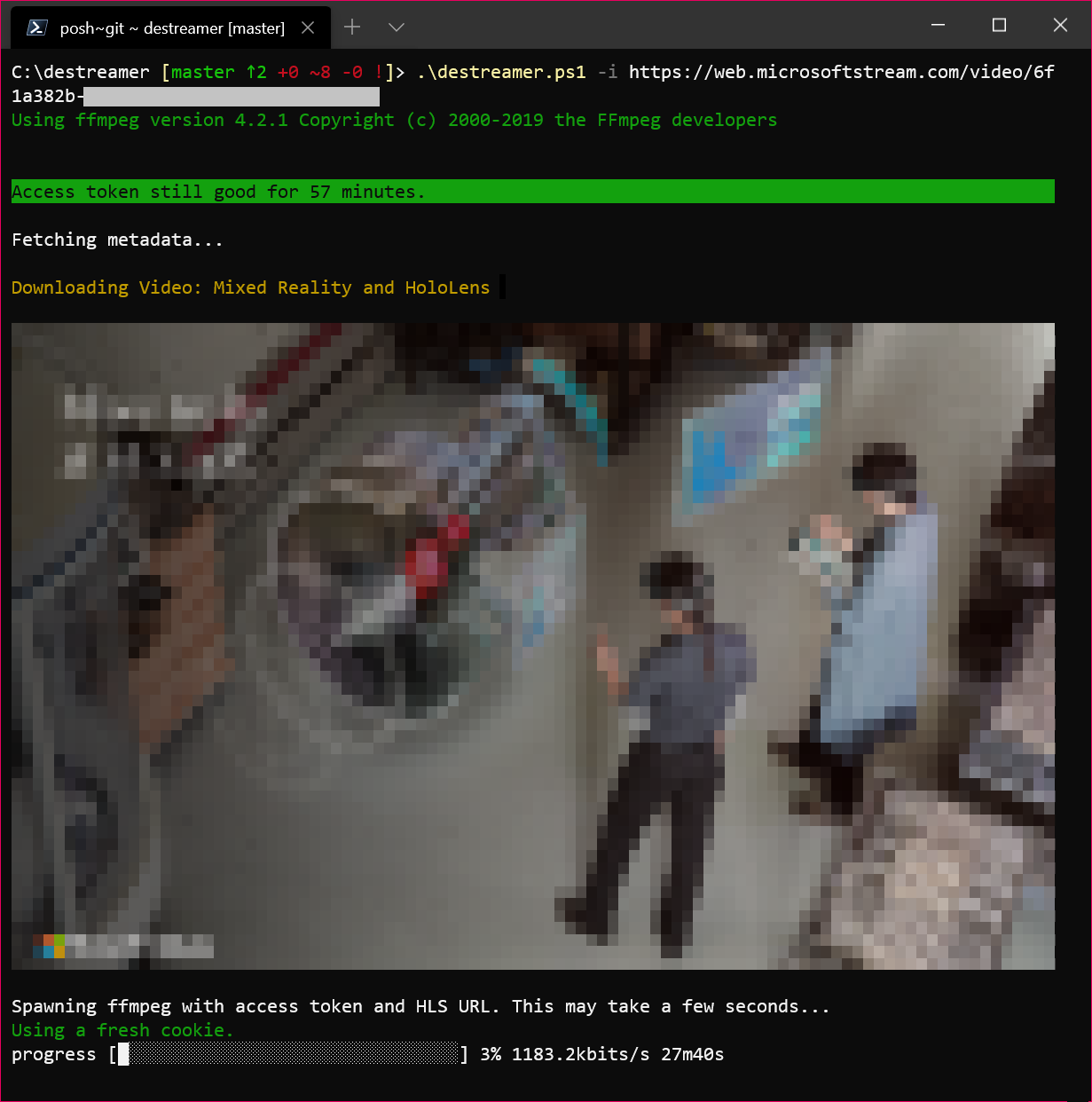| .github | ||
| .vscode | ||
| assets | ||
| scripts | ||
| src | ||
| test | ||
| .eslintrc.json | ||
| .gitignore | ||
| CONTRIBUTING.md | ||
| destreamer.cmd | ||
| destreamer.ps1 | ||
| destreamer.sh | ||
| LICENSE | ||
| package-lock.json | ||
| package.json | ||
| README.md | ||
| tsconfig.json | ||
 (Alternative art proposals are welcome! Submit one through an Issue.)
(Alternative art proposals are welcome! Submit one through an Issue.)
Saves Microsoft Stream videos for offline enjoyment
v2.0 Release, codename Hammer of DawnTM
This release would not have been possible without the code and time contributed by two distinguished developers: @lukaarma and @kylon. Thank you!
What's new
- We now have a token cache so we can reuse access tokens. This really means that within one hour you need to perform the interactive browser login only once.
- We removed the dependency on
youtube-dl. - Getting to the HLS URL is dramatically more reliable as we dropped parsing the DOM for the video element in favor of calling the Microsoft Stream API
- Fixed access token lifetime bugs (you no longer get a 403 Forbidden midway though your download list)
- Fixed a wide variety of other bugs, maybe introduced a few new ones :)
Disclaimer
Hopefully this doesn't break the end user agreement for Microsoft Stream. Since we're simply saving the HLS stream to disk as if we were a browser, this does not abuse the streaming endpoints. However i take no responsibility if either Microsoft or your Office 365 admins request a chat with you in a small white room.
Prereqs
- Node.js: anything above v8.0 seems to work. A GitHub Action runs tests on all major Node versions on every commit.
- npm: Usually comes with Node.js, type
npmin your terminal to check for its presence - ffmpeg: a recent version (year 2019 or above), in
$PATHor in the same directory as this README file (project root).
Destreamer takes a honeybadger approach towards the OS it's running on. We've successfully tested it on Windows, macOS and Linux.
How to build
To build destreamer run the following commands, in order -
npm installnpm run -s build
Usage
$ ./destreamer.sh
Options:
--help Show help [boolean]
--version Show version number [boolean]
--videoUrls, -i List of video urls [array]
--videoUrlsFile, -f Path to txt file containing the urls [string]
--username, -u [string]
--outputDirectory, -o The directory where destreamer will save your
downloads [default: videos] [string]
--outputDirectories, -O Path to a txt file containing one output directory
per video [string]
--noExperiments, -x Do not attempt to render video thumbnails in the
console [boolean] [default: false]
--simulate, -s Disable video download and print metadata information
to the console [boolean] [default: false]
--verbose, -v Print additional information to the console (use this
before opening an issue on GitHub)
[boolean] [default: false]
Make sure you use the right script (.sh, .ps1 or .cmd) and escape char (if using line breaks) for your shell.
PowerShell uses a backtick [ ` ] and cmd.exe uses a caret [ ^ ].
Download a video -
$ ./destreamer.sh -i "https://web.microsoftstream.com/video/VIDEO-1"
Download a video to a custom path -
$ ./destreamer.sh -i "https://web.microsoftstream.com/video/VIDEO-1" -o /Users/hacker/Downloads
Download two or more videos -
$ ./destreamer.sh -i "https://web.microsoftstream.com/video/VIDEO-1" \
"https://web.microsoftstream.com/video/VIDEO-2"
Download many videos but read URLs from a file -
$ ./destreame.sh -f list.txt
You can create a .txt file containing your video URLs, one video per line. The text file can have any name, followed by the .txt extension.
Passing --username is optional. It's there to make logging in faster (the username field will be populated automatically on the login form).
You can use an absolute path for -o (output directory), for example /mnt/videos.
Expected output
By default, downloads are saved under videos/ unless specified by -o (output directory).
Found a bug?
Please open an issue and we'll look into it.
